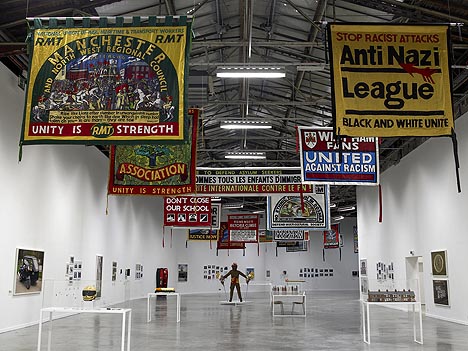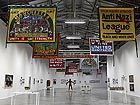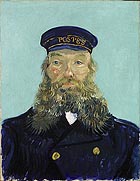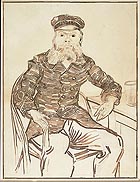
translated and summarized by: Liz Wollner-Grandville,
English summary November 24 - 30
Palais de Tokyo: From One Revolution to Another – Carte Blanche à Jeremy Deller
Asking the right question
“A good ‘Carte Blanche’ depends on the artist. He will present his choice of art, and will not let himself be controlled by directors or curators of the museum. It is a very personal project in a public space”, said Jeremy Deller in an interview about his Carte Blanche at the Palais de Tokyo. The British winner of the prestigious Turner-prize (2004) was given free rein for his presentation in the lower rooms of the Palais. “From One Revolution to Another” explores the influence of the Industrial Revolution on the last decades of cultural history, and puts together works from Great Britain, France, and the Soviet Union.
Deller selected pieces from various archives for this exhibition. By choosing groups and artists who have little to do with the mainstream, he aims at praising the entire creative production potential of a society. The exhibit places pop culture, folk art, and everyday creative potential of the so-called ‘Underground’ in the centre of attention. Innumerable colourful banners made by Ed Hall hang from the ceiling and convey the feeling of a folk festival. Only when you read what is written on these banners does the political and social commitment over the last 20 years in England become clear. The “Folk Archive”, which Deller put together with Alan Kane some time ago, is shown in Paris and functions in a similar way. It presents a collection of contemporary folk art and celebrates Great Britain’s creativity, focussing on activities such as political statements, performances, objects, and poetic contributions mainly produced by untrained “outsider” artists.
The creative music potential is represented by showing the beginnings of French rock, the proletarian background of British pop music, and a selection of sound experiments made in the Soviet Union during the 1920s – all with the help of archive material, photographs, memorabilia, and videos.
But can Jeremy Deller change the view we have of the already established canon on high art, folk art or possibly even Kitsch? Can the British artist bring the areas of “mainstream” and “underground” a little closer to us? The question is, do we as observers, actually want that? Maybe the goal of this exhibit is to make us reflect on which role “underground” played in our society? Presumably this is the question this exhibition is asking the visitor.
Palais de Tokyo
75116 Paris, 13 Avenue de President Wilson, until 04.01.09
www.palaisdetokyo.com
Kunsthalle Wien project space: Wangechi Mutu – In Whose Image?
Horror Beauties with torn souls
The inclination to deform and inflict pain to one’s own body is a common practice in many cultures and has different psychosomatic roots and cultural meanings. Tattoos and cuts were highly esteemed by primitive tribes. Nowadays they are more of a fashion statement or proof of an individual life style.
Kenyan born artist Wangechi Mutu’s grotesque and strange individuals, which are depicted in her colourful collages made of newspaper clippings, pornographic magazines, medical books, glitter, adhesive tapes or rabbit fur and leather made her famous in the USA. Mutu, who moved to New York in the 1990s, was compared to internationally renowned artists such as Nara, Murakami or Essenhigh. Her figures challengingly take up the stereotype essentials of a mystic, primitive, simple and post-colonial “exotic femininity”. They also represent the western ideals of excessive sexuality and are both innocent as well as guilty: “Amazing Graces”, witches, or African Lora Crafts – the insubordinate strong and at the same time neurotic women, who self-consciously fight against all evil ,and whom one should never stand in the way.
The project space at the Kunsthalle Wien is focusing on Mutu’s portraits, among them the well-known collage edition “Histology of the Different Classes of Uterine Tumours” as well as new double portraits, comparable with profiling photos depicting faces from the front and the side. They are composed of different body parts, jewels, and parts of motorbikes that flow into one another. The portraits of these anonymous horror hybrids are of a true artistic magnificence and remind of Arcimboldo’s art historical superiority as well as Gustav Klimt’s elegance.
The earlier collages show mask-like portraits of mutating creatures. These monstrous faces, often decorated with black glitter and thereby reminding of ornamental (death) masks, connect modern vision with provenance and folklore.
Kunsthalle Wien project space
1040 Vienna, Karlsplatz/Treitlstrasse 1-3, until 07.12.08
www.kunsthallewien.at
Albertina: Van Gogh
Genius, unravelled
Today nobody can imagine, what the art critic Berta Zuckerkandl complained about on February 1, 1900: “The Albertina has its own sweet secret – the museum has a Dürer exhibit. Insiders only know this well kept secret, and only by coincidence do art lovers find out. It was not published anywhere. Why should such an internal affair as the presentation of Dürer’s hand drawings be publicized! It is sufficient if the director, the custodians, and a handful of art critics know about this exhibit.” How the times have changed!
This time we are not dealing with Dürer – he had his turn in 2003 – but with Vincent van Gogh. And: One can really learn something from this exhibition. It focuses on the correlation of van Gogh’s drawings with his paintings – or – as the text on the wall reads: “The principle of drawing as the basis of the entire oeuvre”.
Van Gogh was 27 when he started his autodidactic career by drawing. During the first three years of his only ten years as an artist, he concentrated on drawings, influenced by English and French graphic art theory. Already at that time he created a series of autonomous works, which play an important role in his oeuvre. In 1886 van Gogh joined his brother in Paris, where he discovered that the dark colours of his paintings seemed anachronistic compared to those used in Impressionism. His palette became more colourful and his lines more impressionistic.
In 1888, first in Arles, later in Saint-Rémy and Auvers-sur-Oise, his paintings become something like the “practice material” for his drawings, whose coarse and rather drab style was transformed into colourful paintings – and vice versa: Van Gogh created paintings based on drawings and then again composed drawings based on these paintings. He took great care regarding the transformation of tones into colours and colour planes into graphic elements (and vice versa).
The effect is interesting: on the one side we have paintings, created during his last two and a half years, which are dominated by expressive colourful lines, and on the other side the respective graphics and drawings, which unravel van Gogh’s genius. They show how much work and thoughts were invested in the new artistic solutions. And it is exactly this, which raises his drawings onto the same level as his paintings – something, which, however, does not really come as a surprise in a graphics museum.
Albertina
1010 Vienna, Albertinaplatz 1, until 08.12.08
www.albertina.at
Austrian Cultural Forum New York: Cutting Realities – Gender Strategies in Art
Bananas, of all things
Dorit Margreiter is practicing. Not for her participation at the upcoming Biennial in Venice, but with a baseball serving machine in the video installation “Jock”. And Tanja Ostojic also tries hard to take the right turn on the road to success. She staged herself in “I’ll be your angel” at the 2005 Biennial in Venice, which was meant to analyze strategies of perception within the art circus. Both Margreiter and Ostojic react to the medial aspects of gender presentation and – reception. The basic idea of the exhibition “Cutting Realities” is hidden in the cultural turn of 1968: the curator Walter Seidl is attempting to determine if the upheavals of the 1960s had a lasting effect on art history. To do so he employs works from the Erste Bank Collection “Kontakt”, which focuses on Southern and Central Eastern European political and feministic standpoints. Valie Export’s “Tapp- und Tastkino” (1968) as well as her “Body Sign Action”(1970) both take a central position – as does the work by the today 80-year old Bela Kolárová. Natalia LL unmasked the trivial-male view of banana eating women in the erotic video “Consumer Art” (1972). From today’s viewpoint it seems rather banal: gender strategies in art have been around for at least 40 years, and in addition to feminist perspectives, the topic of cross-gender questions joined in quite some time ago. Gender identification is consciously disregarded in Hans Scheirl’s “Street Images”, and Artur Zmijewski unmasks the basic triviality of a body in his videos. The posters by Seljla Kameric at the entrance to the exhibit make it clear that it still has a lot to do with sensitising the public: they depict the shocking graffito of an unknown UN soldier in Srebrenica copied over a photo of herself: “No Teeth, A Moustache, Smells Like Shit…? Bosnian Girl!”
Austrian Cultural Forum New York
10022 New York, 11 East 52nd Street, until 29. 11. 08
www.acfny.org
Mehr Texte von translated and summarized by: Liz Wollner-Grandville


 Teilen
Teilen






